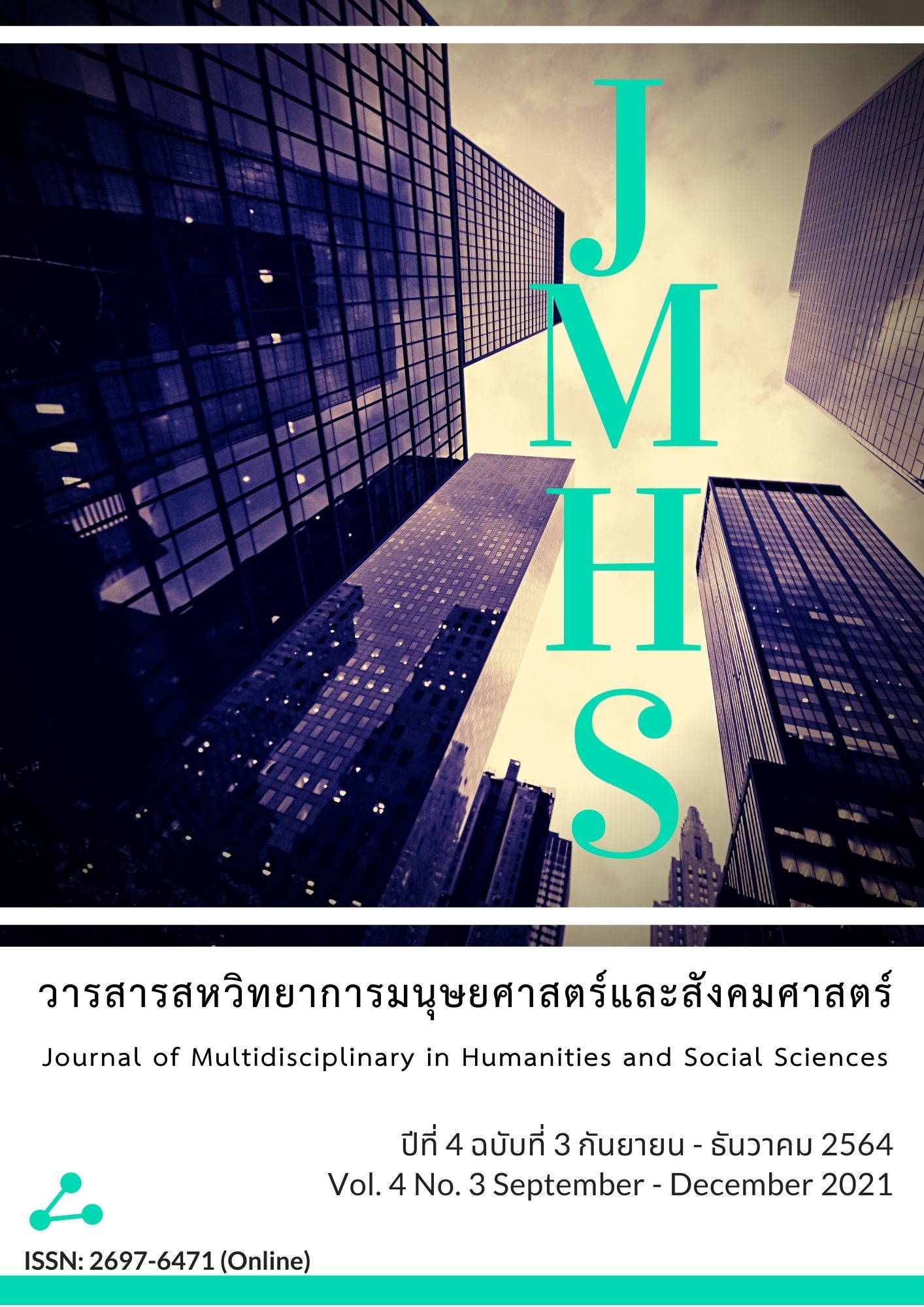Public Participation in Conservation Water Hyacinth Basketry Work, A Case Study in Sappaya District Sapphaya District, Chainat Province
Main Article Content
Abstract
This article aimed to study 1) the level of public participation in the conservation of water hyacinth basketry; and 2) compare the level of participation in water hyacinth basketry conservation by gender, age, occupation, marital status, education level, and average monthly income. This study was quantitative research. The tool was used as a questionnaire, collecting data from 350 people in the Sappaya area. Data were analyzed using percentages, mean, and standard deviation. The hypothesis was tested using a t-test. One-way ANOVA or F-test was used to compare the mean of the independent variables and the one-way ANOVA or F-test. Comparison of two pairs by Scheff's Test. It was found that
The level of participation in water hyacinth basketry conservation in the area of Sappaya Sub-district, Sapphaya District, Chai Nat Province, overall, was found that the overall participation level was moderate. When classified by each aspect, it was found that the aspects with the highest level of participation were, in order of participating benefits, decision-making evaluation, and the operational aspects, respectively. The results of the hypothesis testing of the differences between the personal characteristics were found that the participation in the conservation of water hyacinth wickerwork of people with sex, age, occupation, marital status, education level, income differed at different levels of participation. Participation in the conservation of water hyacinth basketry should develop a modern product design. The development of creative craftsmen continuously searches for suitable production techniques and processes providing knowledge on raw material management to reduce the risk of loss and distribution channels that are diversified and up to date, suitable for today's target audience.
Article Details
Views and opinions appearing in the Journal it is the responsibility of the author of the article, and does not constitute the view and responsibility of the editorial team.
References
ชาญชัย ศุภอรรถกร, อินทุอร สิงห์แก้ว และ วรินทร พิมพาชัย. (2562). การพัฒนาหนังสือสามมิติ เรื่อง หัตถกรรมเครื่องจักสานและเครื่องปั้นดินเผาด้วยเทคโนโลยีออกเมนเต็ดเรียลลิตี บนระบบปฏิบัติการแอนดรอยด์. วารสารเทคโนโลยีสารสนเทศ, 15(1), 81-92.
พรทิพย์ สุขสงวน. (2557). ศักยภาพการบริหารจัดการกลุ่มผลิตภัณฑ์ชุมชนในจังหวัดพระนครศรีอยุธยา(วิทยานิพนธ์บริหารธุรกิจมหาบัณฑิต). มหาวิทยาลัยราชภัฎพระนครศรีอยุธยา.
ธนกรณ์ ศิริสุขโภคา. (2555). การศึกษาวิเคราะห์ผลิตภัณฑ์เครื่องจักสานผักตบชวา กรณีศึกษาตำบลไทรงาม อำเภอบางเลน จังหวัดนครปฐม(วิทยานิพนธ์การศึกษามหาบัณฑิต). มหาวิทยาลัยศรีนครินทรวิโรฒ.
นพพล เกตุประสาท. (2557). กาบหอยแครง. สืบค้นเมื่อ 13 พฤศจิกายน 2563, จาก http://clgc.rdi.ku.ac.th/index.php/ornamental/371-tradescantia
ปาริชาติ วลัยเสถียร. (2543). กระบวนการและเทคนิคการทางานของนักพัฒนา. กรุงเทพฯ: สำนักงานกองทุนสนับสนุนการวิจัย.
ปรางทิพย์ สุขเจริญดีแท้. (2563). การวิเคราะห์ต้นทุนและผลตอบแทนของการทำเครื่องจักสานผักตบชวาและหวาย กรณีศึกษากลุ่มวิสาหกิจชุมชนจักสานผักตบชวาและหวาย ตำบลบ้านรี จังหวัดอ่างทอง(วิทยานิพนธ์บริหารธุรกิจมหาบัณฑิต). มหาวิทยาลัยเทคโนโลยีราชมงคลสุวรรณภูมิ.
พรทิพย์ สุขสงวน. (2557). ศักยภาพการบริหารจัดการกลุ่มผลิตภัณฑ์ชุมชนในจังหวัดพระนครศรีอยุธยา(วิทยานิพนธ์บริหารธุรกิจมหาบัณฑิต). มหาวิทยาลัยราชภัฎพระนครศรีอยุธยา.
ภาวินี อินทวิวัฒน์. (2555). การมีส่วนร่วมของชุมชนในการอนุรักษ์ผ้าทอหม้อห้อม: กรณีศึกษาตำบลทุ่งโฮ้ง อำเภอเมือง จังหวัดแพร่(วิทยานิพนธ์การศึกษามหาบัณฑิต). มหาวิทยาลัยศรีนครินทรวิโรฒ.
ยุวดี พรธาราพงศ์. (2562). การออกแบบรูปทรงแม่แบบเครื่องจักสานผักตบชวาสู่ผลิตภัณฑ์สร้างสรรค์แนวคิดเอกลักษณ์ท้องถิ่น. วารสารวิชาการและวิจัย มทร.พระนคร, 4(1), 18-33.
วิลาวัลย์ มีอินถา. (2553). การพัฒนาเศรษฐกิจชุมชน กรณีศึกษา อำเภอท่าปลา จังหวัดอุตรดิตถ์. เชียงใหม่: มหาวิทยาลัยเชียงใหม่.
เศรษฐา เหลากล้า. (2562). การศึกษาองค์ความรู้และต่อยอดภูมิปัญญาพื้นบ้านในการใช้เครือซูดวัสดุธรรมชาติ เพื่อเศรษฐกิจสร้างสรรค์ในรูปแบบของเครื่องจักสาน. วารสารกระแสวัฒนธรรม, 20(38), 53-65.
สุวิมล ติรกานันท์. (2543). การประเมินโครงการ:แนวทางสู่การปฏิบัติ. กรุงเทพฯ: คณะศึกษาศาสตร์, มหาวิทยาลัยรามคำแหง.
อภิชาติ ใจอารีย์. (2559). กระบวนการมีส่วนร่วมแบบพหุภาคีเพื่อการจัดการสิ่งแวดล้อมอย่างยั่งยืน: กรณีศึกษาการจัดการป่าชุมชนบ้านพุเตย จังหวัดกาญจนบุรี. วารสารมหาวิทยาลัยศิลปากร ฉบับภาษาไทย, 38(1), 111-136.
อัญชลี คงทอง. (2553). แบบอย่างในการพัฒนาอาชีพจักสานอำเภอพนัสนิคม จังหวัดชลบุรี(วิทยานิพนธ์รัฐประศาสตร์มหาบัณฑิต). มหาวิทยาลัยขอนแก่น.
อุษา โบมานน์, คณิต เฉลยจรรยา และ ฑิฆัมพร ทวีเดช. (2560). รูปแบบการพัฒนาผู้ประกอบการอุตสาหกรรมโอทอปภายใต้หลักปรัชญาเศรษฐกิจพอเพียง. วารสารพัฒนาเทคนิคศึกษา มหาวิทยาลัยเทคโนโลยีพระจอมเกล้าพระนครเหนือ, 29(103), 56-65.
โองการ วณิชาชีวะ (2558). ลักษณะพันธุกรรมของวัชพืชรุกรานต่างถิ่นผักตบชวาในประเทศไทย. วารสารวิทยาศาสตร์และเทคโนโลยี, 23(3), 485-496.


